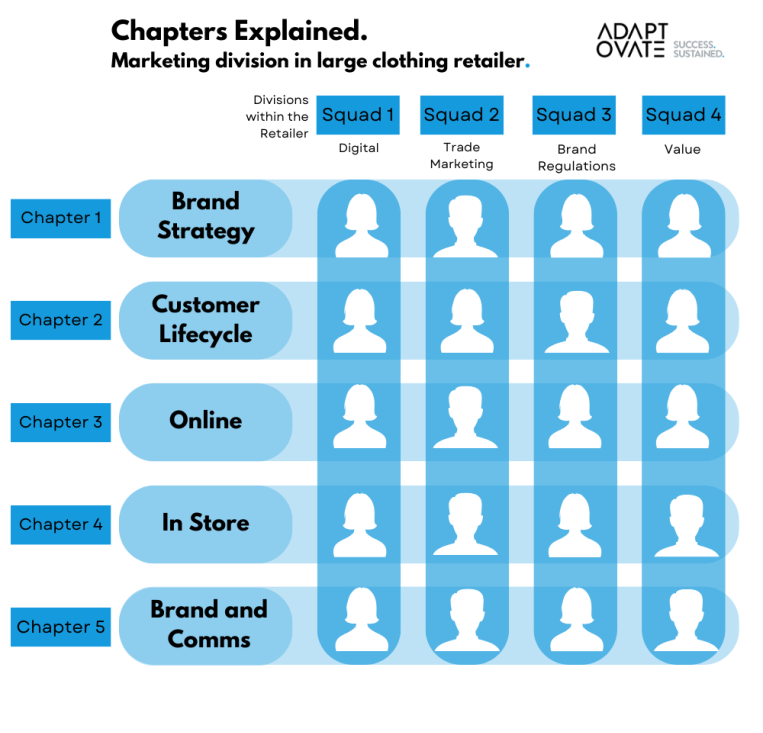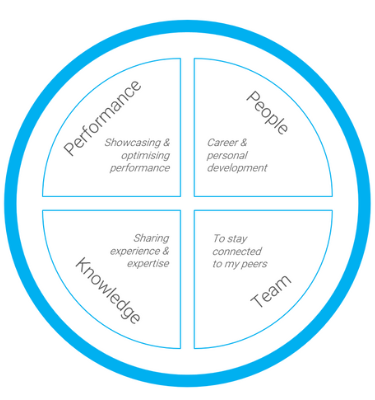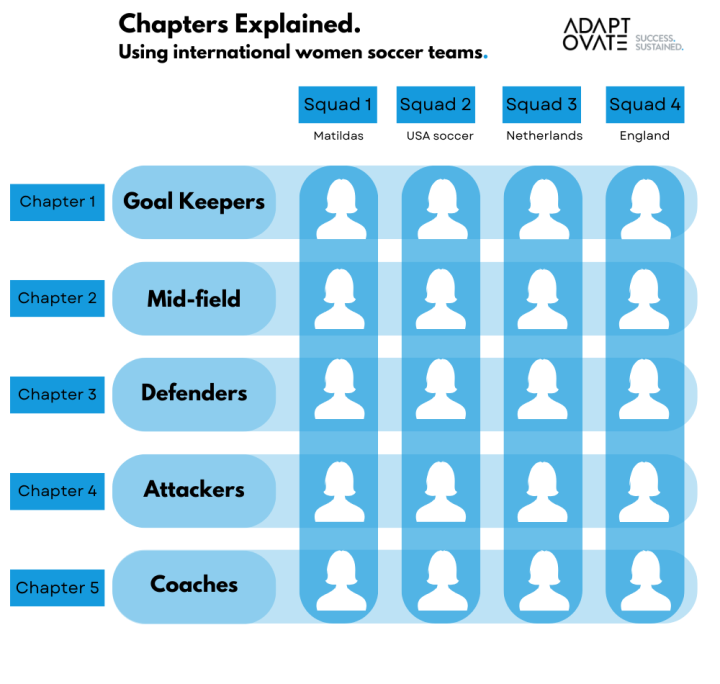What are Chapters in an Agile Operating Model?
Understand what Chapters are within new ways of working, and who the people are that sit within these Chapters.
To read more and hear from our Sydney-based Managing Partner Laura Scott on building capability with the chapter model and a real-life case study visit this page on: Mastering Business Agility and the Spotify Model Agile Approach.
The Spotify Model? Tribes? Chapters? Squads? – What’s it all mean?
It’s been a decade since Henrik Kniberg shared the Spotify Model on his blog.
It was a vision for how Spotify would implement their operating model moving forward, as a work in progress. Not intended to be set in stone – but a new model that could be adapted with time and experience.
At its heart was the idea of a different type of team structure that differed from established organisations. That is – a new way people fitted into a business by a new framework. Importantly, that framework may change from business to business, depending on their needs, weaknesses, products and consumers.
Chapters are a way of organising teams around their expertise and craft, where individuals with similar skills or functions are grouped together into “chapters,” each led by a Chapter Lead.
The Chapter Model empowers teams to swiftly adapt to new information, technologies, and methodologies. This adaptability is vital in rapidly evolving fields such as AI, sustainability and cybersecurity, allowing teams to modify or refine their strategies in response to the latest research, technological advancements, or emerging threats.
Chapters are being used successfully to allow old, entrenched organisations reframe how they operate internally, and more specifically accelerate excellence within the business, and ultimately deliver a better product for the customer.
For this article we are specifically what a Chapter is and where does it fit into an agile framework. Let’s assume you know a little bit about Agile and the concepts. If not, visit the Agile Operating Model case study for a quick overview, or read through some ADAPTOVATE articles to help fill in the picture.
WHERE DO CHAPTERS FIT IN? IT’S ALL ABOUT CAPABILITIES.

The core of developing a new operating model, is to restructure teams into cross-functional teams aligned to an agreed objective and key result.
What does a cross-functional team mean?
A team with different specialised capabilities designed to work collectively to deliver autonomously an output that serves a customer’s need.
This model has two components:
- “Squads” are cross-functional teams which include individuals with different specialised capabilities designed to work collectively to deliver autonomously an output that serves a customer’s need.
- “Chapters” are all about skills. They focus on improving abilities, sharing knowledge, and setting the standard for excellence to bring the best version of themselves to the Squad. Think of areas like Brand Strategy or customer lifecycle.
In a business you would typically have many Squads that form part of a Tribe. That Tribe would have a distinct mission within the business. Large organisations can have many Tribes.
While Chapters focus on the “how” of doing things, Squads and Tribes look at the “what.”
A marketing team at a financial institution
Mina Gurgis, a project lead with us, gives this example, “In an operating model for a marketing team in a financial institution, UX designers formed a Chapter – their home team. Although each UX designer is working in a different team, they need to get together (as part of their home team) on a regular basis to ensure consistency in UX design across all the work they do.
This ensures customers’ experience is the same regardless of what product/service they are engaging with. Also, the UX designers were able to upskill each other with the guidance of a Chapter Lead in the latest tools and processes available to make their work more efficient and also grow in their professional career,” Mina explains.
A CHAPTER IS WHERE ‘MY PEOPLE’ ARE. Let’s call it HOME.
Chapter time, otherwise known as coming ‘home’, typically refers to the dedicated time set aside for members of a chapter to meet, collaborate, and engage in activities related to their specific area of expertise or interest.
This ensures individuals are not only focused on their project work but also can grow in their roles, contribute to the wider organisation, and stay updated with the latest developments in their field.
Chapter Time: Mastering the Balance between Work and Growth
The distinction between “delivery” and “home” essentially differentiates between the project-focused, outcome-driven nature of squads and the skill-focused, development-oriented nature of chapters.
Finding the right rhythm for chapter time can be challenging. A practical solution we’ve found is adopting the 80/20 rule, allocating Monday to Thursday for Squad-related tasks, while Friday is reserved for Chapter activities.
Mina provides this advice, “Bring this up during the planning meetings with the Squad and take on as much work as possible with a buffer for Chapter time (i.e. personal development). This is also an opportunity to have a good discussion between the Chapter Leads and Product Owners on how to balance the delivery of business outcomes and the upskilling of people who deliver that work.”
(For the sake of this article, a simple description of the Product Owner is the role that owns the purpose, vision, and outcomes of the Squad. The PO sets the direction through prioritisation of work.)
Returning Home
The essence of returning “home” to your Chapter on Fridays is about more than just skill enhancement; it’s where you share challenges, learn from peers, and seek ways to consistently elevate your specialised capabilities.
By everyone developing the same skills and capabilities it ensures that when you return to your respective Squads, you are bringing the same capability excellence to your Squad. Singing from the same songbook so to speak. Which means there is an alignment across the Squads and Tribes on how things are executed.
Chapter time aims to develop four key areas:
The essence of returning “home” to your Chapter on Fridays is about more than just skill enhancement; it’s where you share challenges, learn from peers, and seek ways to consistently elevate your specialised capabilities.
By everyone developing the same skills and capabilities it ensures that when you return to your respective Squads, you are bringing the same capability excellence to your Squad. Singing from the same songbook so to speak. Which means there is an alignment across the Squads and Tribes on how things are executed.
Chapter time aims to develop four key areas:

Leveraging Sports Analogies: The Matildas’ Olympic Journey and Specialised Training Chapters
Within ADAPTOVATE (depending on who is doing the consulting) we will also often defer to a good old sports analogy. Imagine the Matildas soccer team, where goalkeepers, defenders, midfielders, and attackers each play a pivotal role. This cross-functional ‘Squad’ unites with a common goal: to win the Olympics. In the Agile framework, individuals with shared skillsets, such as defenders, form what we call Chapters.
These Chapters are not just groups; they are masters of their craft, where specialised skills are developed and shared. For the Matildas, this means attackers perfecting their goal-scoring abilities, while defenders and goalkeepers strengthen their strategies to block the opposition. Training sessions are meticulously designed, allowing Chapters to refine their skills in isolation—goalkeepers may focus on penalty saves, whereas midfielders might concentrate on agility and ball control.
Yet, the true strength of the team comes from working together. Group practices are crucial, helping them coordinate their game plans and improve as a team. Each player is both an expert in her craft, as well as collaborating with teammates from other Chapters. This makes them strong competitors for the Olympics.
In fact, it’s always encouraged that every team member has a “T” shaped skillset – deep knowledge in their Chapter area, and less deep but wider knowledge in other areas.
It’s no different in a workplace, where each of us comes from a different background and work in a different area (e.g. HR, Finance, IT) yet we need to get together to solve problems effectively for our organisation.

The Chapter Lead
The role of a Chapter Lead is centred around domain-specific expertise and the professional development of their team members, rather than direct project management. Chapter Leads play a crucial role in mentoring, skill development, performance management, recruitment, and knowledge sharing within their craft. They focus on identifying skill gaps, offering guidance, and ensuring their team remains proficient and up to date with industry best practices and technologies.
A Partner in Sydney explains, “There is talk of empowerment and teams self-managing, however, how to achieve that often feels elusive. Chapter Leads fill the missing role to guide people on how to get the work done in a consistently high-quality manner. This role sets guidelines, provides best practice examples and guides the professional capability development of the people within the teams.”
Chapter Leads face significant challenges as the role is not widely understood and may result in conflict and lack of clear accountability. Chapter Leads must clearly understand their role.
Visit our full guide for Chapter Leads: Embracing the Role of a Chapter Lead: A Guide for Aspiring and Current Leaders
Reporting lines and the performance management framework.
While at ‘home’ in your Chapter, the dynamics of requesting leave and performance reviews shift from traditional manager-employee interactions.
The question arises: who evaluates chapter members during performance reviews? In Chapters, you ask your Chapter Lead. That is the person that is leading the charge within your capability chapter. Your new ‘manager’.
The Chapter Lead works closely with the Delivery Lead to conduct a comprehensive performance assessment. This collaboration ensures informed decisions on promotions, addressing the challenge of reporting lines through clear guidelines and open communication.
By maintaining strong communication between the Chapter Lead and the Delivery Lead, early challenges related to reporting lines and performance management can be effectively managed.
Talk to us today if you would like to explore different ways you can organise your team into Chapters to support their personal and professional growth.
Locations
USA
AUSTRALIA & NEW ZEALAND
Sydney
Level 8/341 George St
Sydney NSW 2000
+61 2 7200 2530
Melbourne
Suite 22-125 120 Spencer Street,
Melbourne VIC 3000
+61 2 7200 2530
Canberra
Suite 3, Ground Floor/65 Canberra Ave
Griffith ACT 2603
+61 2 7200 2530
Auckland (Tāmaki Makaurau)
Level 4, ACS House, 3 Ferncroft Street,
Grafton, Auckland 1010
New Zealand
SINGAPORE
20 Collyer Quay, Level 12,
Singapore
+65 98348486
POLAND
ul. Czackiego 15/17
00 -043 Warszawa
+48 505 626 416
CANADA
Postal location:
110 Cumberland Street Suite # 307
Toronto ON M5R 3V5
Physical office location:
296 Richmond St. West
Toronto, ON M5V 1X2
Canada
+1 647 631 1205
UK
5th Floor, 167-169 Great Portland Street
London W1W 5PF
+44 20 3603 1662
PHILIPPINES
19th Floor, Two Neo Building
3rd Avenue corner 28th Street
Bonifacio Global City, Taguig City
+65 98348486

About us
Key Approaches
Industries
Trending Topics
©2022 ADAPTOVATE. All rights reserved




